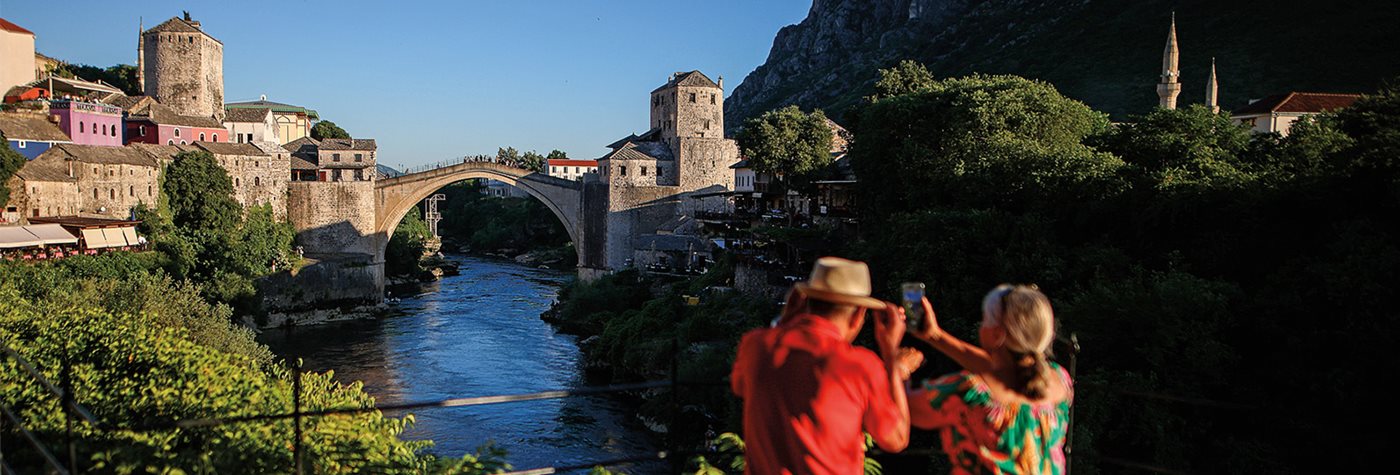
The Mostar Bridge Over Troubled Waters: A Case Study in Reconciliation.
History
Language Studies
Europe
Written by Brian E. Clark and photos courtesy of Amir Zaki.
Learn how the idioms and metaphors of a bridge destroyed during the Bosnian Civil War express the sentiment of a people.
The following activities and abridged text build off “The Bridge of Meaning,” written by Ian Bancroft and photographed by Armin Durgut.
WARM UP
Complete these prereading activities.
IF YOU ONLY HAVE 15 MINUTES ...
Understand idioms and metaphors in writing and how they are used.
IF YOU ONLY HAVE 30 MINUTES ...
Learn how the “Stari Most” (Old Bridge) influenced and impacted the people and culture of Mostar, and how the bridge’s reconstruction helped reconcile the people of Bosnia-Herzegovina.
VISUAL ANALYSIS
Formulate a short presentation on the reconstruction of a bridge using images.
Directions: As you read, you will notice certain words are highlighted. See if you can figure out what these words mean based on the context. Then click the word to see if you’re right.
The Bridge of Meanings
The bridge is a well-known icon of Bosnia-Herzegovina and Mostar. It is replicated in paintings and drawings in many public places—cafes, restaurants, museums, and galleries
The city’s fabric is woven into every piece, with culture and heritage inseparable from the towering arch that transcends the Neretva River. Its image is arguably the nation of Bosnia-Herzegovina’s most famous and iconic.
 Edin “Dino” Šipković works on a painting of the Old Bridge in the old part of Mostar.
Edin “Dino” Šipković works on a painting of the Old Bridge in the old part of Mostar.
The beauty of the bridge is that it connects with nature. The stone and the trees all become one piece. It is this harmony that bestows tranquility upon its surroundings and inspires artists here and beyond.
But that sense of peace was shattered during the 1992–1995 war in Bosnia, following the breakup of Yugoslavia. That moment of destruction by some members of the Croatian military in 1993, is engraved upon the memories of those for whom the bridge was so precious. There were no communication lines available to report on the destruction. The silence flourished the augmented emotion of loss. It was hard for residents to envision Mostar without its defining feature.
Question: During what event was the bridge across the Nevetva River destroyed?
During the 1992-1995 Bosnian Civil War
Many recalled how the “drops of blood” during the bridge’s destruction oozed out of the ruins. This was merely the seeping red mortar used for waterproofing. Yet the interpretations capture the magnitude of the moment. People spoke about how the “Old Man” had fallen. It was like losing a family member.
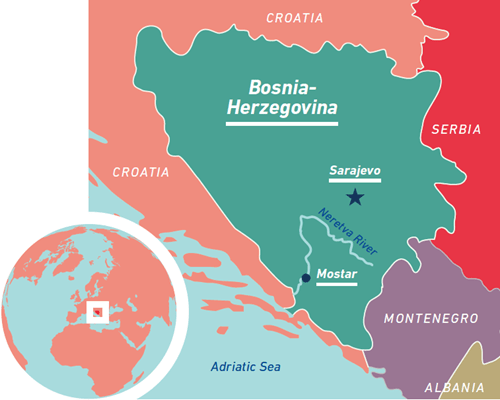
Question: What emotional impact did the loss of the bridge have on the people of Mostar and Bosnia?
It was hard for residents of Mostar to envision their city without the bridge. People were crying for the bridge in the middle of the chaotic war. It was nicknamed “Old Man” and its destruction was like losing a family member.
The loss of the bridge extinguished any semblance of hope in the population that had endured months of shelling and killing. People were crying for the bridge in the middle of chaos. People were crying for the bridge in the middle of chaos. Yet it also inspired citizens’ defiance and a push to rebuild their cultural heritage.
In 2024, the Old Bridge celebrated the 20th anniversary of its opening on July 23, 2004. The achievements of those who were committed to seeing the bridge rise again from the waters beneath were recognized as a UNESCO World Heritage Site.
History of the Original
The bridge was built during the reign of Ottoman Sultan Suleiman the Magnificent in 1566. For 427 years the bridge not only spanned the banks of the river but provided a meeting place for promenading couples and prospective friendships. It had a personal connection to the people for generations. The Old Bridge also sat at the crossroads of Western and Eastern rule, representing an enduring multicultural and multireligious character that have long defined the city’s identity.
Question: Briefly describe the origins of the bridge and its importance to the people of Mostar
The bridge was built during the reign of Ottoman Sultan Suleiman the Magnificent in 1566. It spanned the river, improving transportation. I was a meeting place for people for generations. It sat at the crossroads of Western and Eastern rule defining the city’s multicultural and multireligious identity.
Something else about the bridge has united Mostar’s disparate communities for centuries: diving. For almost as long as the bridge has existed, every summer there has been a competition for find the most elegant jumper. The Mostarians live for this event. Starting at a young age and schooled by their gathers and grandfathers, they are fearless in their pursuit of beauty as that uphold the tradition.
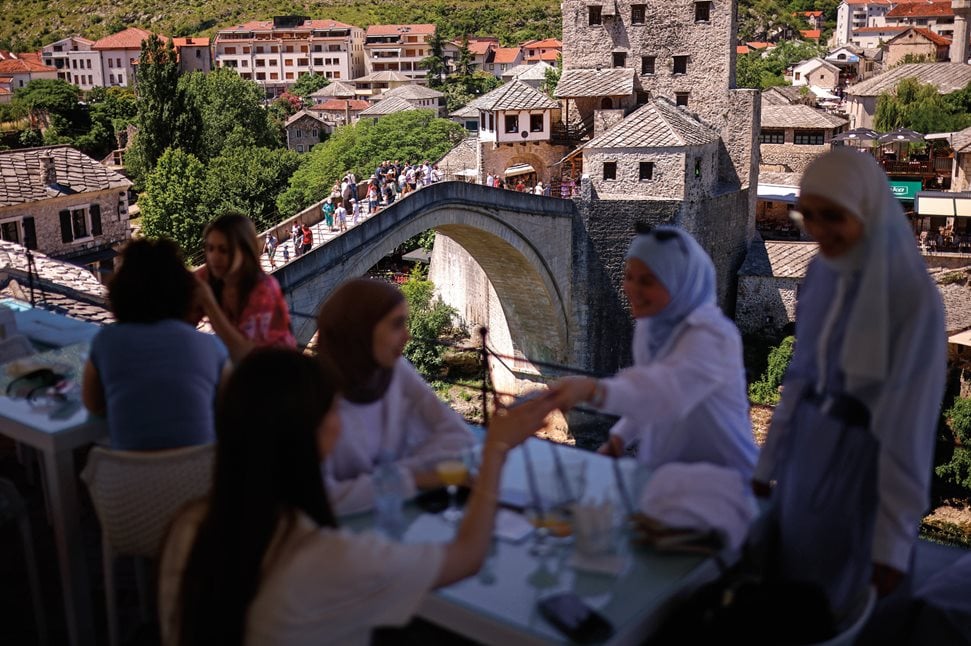 The Old Bridge offers a picturesque backdrop for patrons at coffeehouses and shops in Mostar.
The Old Bridge offers a picturesque backdrop for patrons at coffeehouses and shops in Mostar.
Balancing on the parapets, the divers plunge 24 meters into the turquoise waters. Even in the depth of winter, they delight the ever-increasing numbers of tourists and locals who wait in anticipation of a jump. With mobile phones poised, most dives are rarely viewed with the naked eye. Within seconds they are tagged and uploaded onto social media, cementing Mostar’s place on the virtual map of the world.
An “Architectural Wonder”
The bridge is a unique technological and architectural wonder. The single span of 21 meters, grounded on two rocks, with an 83-centimeter, load-bearing arch. It is constructed from white limestone known for its light weight and strength. It looks to be built out of solid rock but is actually hollow.
The bridge reconstruction owes much to the indomitable efforts of the late architect and professor Amir Pašić, recipient of the prestigious Aga Khan Award in 1986 for his prewar dedication to reconstruction of Mostar’s cultural heritage. Pašić traveled across the globe, organizing lectures at prestigious universities and gathering architects for annual workshops to plan the reconstruction. Entitled Mostar 2004, the project started abroad at the time the old city was under daily bombardment in the early 1990s and continued in postwar Mostar.
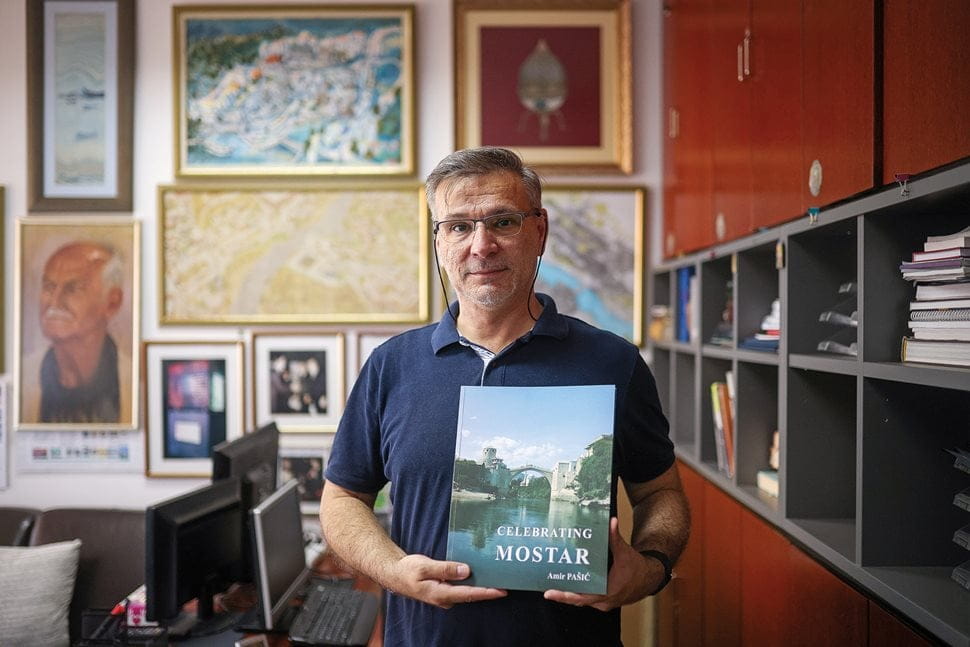 Slađan Jakirović, one of the key members of the team tasked with rebuilding the Old Bridge, poses with a copy of Amir Pašić’s book Celebrating Mostar, about the reconstruction of the old town.
Slađan Jakirović, one of the key members of the team tasked with rebuilding the Old Bridge, poses with a copy of Amir Pašić’s book Celebrating Mostar, about the reconstruction of the old town.
Question: Who was the organizer of the bridge’s reconstruction and how did he form a team to plan the rebuilding?
Amir Pašić, architect and professor. He traveled across the globe, organizing lectures and gathering architects at workshops.
Tradition Meets Modern Engineering
The deconstruction of the bridge ruins allowed for an autopsy its autopsy. Archeological surveys revealed key clues about ancient construction methods. There were disagreements and challenges all around. UNESCO experts’ approval was required for each decision about the type of mortar to be used.
In the postwar context, this mixed team of architects, engineers and others overcame the perceptions that prevented others from working together elsewhere in Bosnia- Herzegovina. They became a symbol of reconciliation and a replica of the multicultural workforce that had constructed the original bridge.
Most of the remains of the bridge were too damaged to be reused, despite the heroic efforts of Hungarian army divers who salvaged much of the bridge debris from the river. New stone was mined locally and the stonemasons, predominantly from Turkey. Modern machinery extracted large boulders from the mine and then humans hand cut the stone to fit properly on the bridge.
In a nearby museum dedicated to the ridge’s reconstruction, a documentary film shows each jigsaw piece being placed and joined together. The perfect measurement, the steadiness of the crane and the concentration of the workers combine to set all 1,088 stones. The modern workers admired the construction of the original. Ancient ways of bridge construction had to be modernized. There was no way to dam up the Neretva River when the original bridge was built and prevent the rickety scaffolding from being washed away.
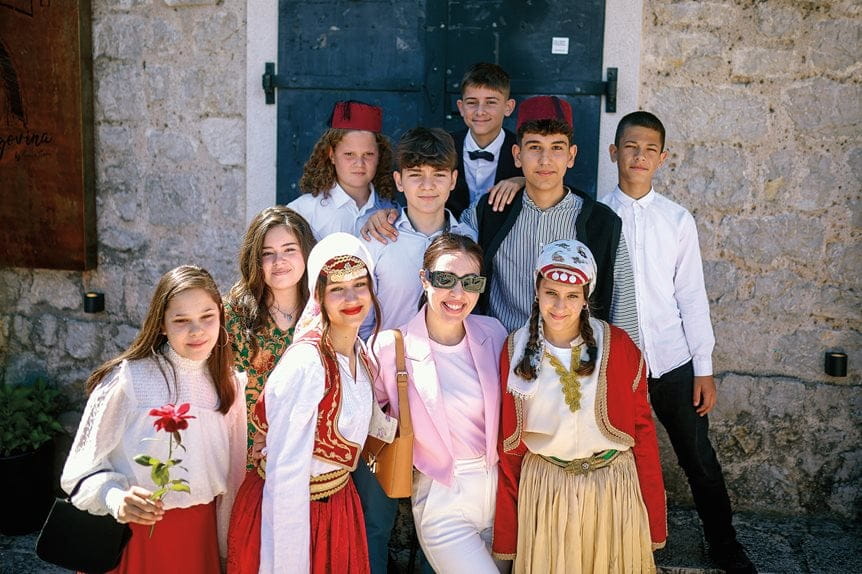
A tourist in Mostar poses with local children in traditional Bosnian dress near the Old Bridge ahead of this summer’s celebration marking 20 years since its reopening.
As the bridge neared completion in 2004, interest grew from the people of Mostar and the surrounding area. The bridge completion became a powerful metaphor for reunification of the country still reeling from the ravages of war. As people from all over Bosnia returned to the site, relationships with the bridge emerged as people experienced the process of repairing the social fabric that had been ravaged by war.
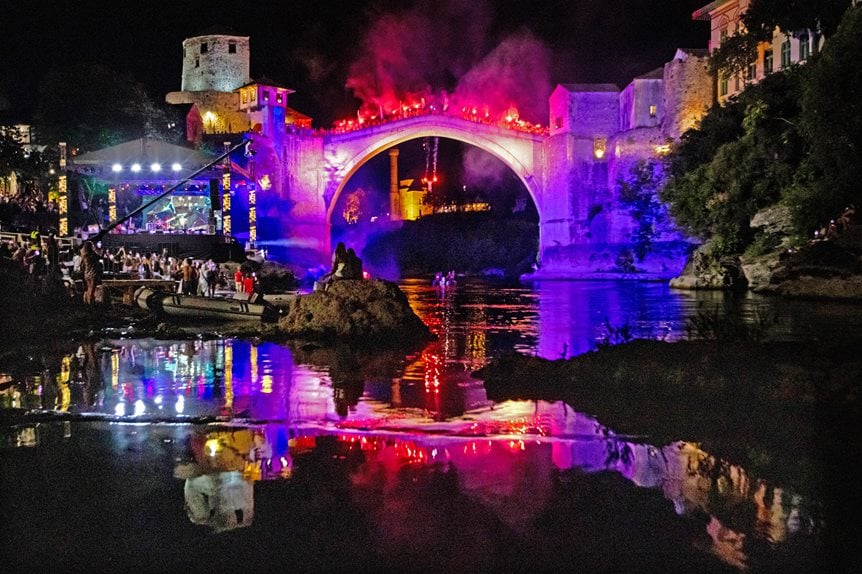 A celebration of the 20th anniversary of the reopening of the Old Bridge on July 23, 2024.
A celebration of the 20th anniversary of the reopening of the Old Bridge on July 23, 2024.
Question: In your own words, explain how the reconstruction of the bridge was a metaphor for reunification of the country.
Answers should contain-- the reconstruction involved people from different nationalities who had to work together for a common cause. Bosnian people began repairing their social fabric ravaged by war.
For those who spearheaded the reconstruction, their expertise remains a profound resource for the world. Their faithfulness to practicing the original construction methods and their powerful commitment to authenticity in an age compromised by quick and often short-lived fixes are the norm. At the bridge’s reopening in 2004, Mostar residents gathered on the riverbanks as fireworks created a blanket of mist of the majestic bridge. Divers, guided only by a single spotlight dazzled the crowed by plunging off the bridge headfirst into the waters below.
In 2024, dignitaries and some of those involved in the reconstruction gathered
to reflect on a chance to be a part of history. By reconstructing the bridge, they returned hope to Mostar and its future generations. After all, the Old Bridge is not, and never has been, just an ordinary bridge.
Other lessons

Tapping Into Andrew Nemr's Story: Exploring Art and an Artist’s Motivation
Art
Levant
Americas
Explore how dancing and storytelling open opportunities for communication among people.
Bringing Cultures Together Through Anime
Art
Geography
History
Arab Gulf
What happens when artists from two very different cultures join forces to create something new?
How Art Connects
For the Teacher's Desk
Art links everything—cultures, history, even math. Want to hook students? Try teaching through the art that surrounds us with these stories.